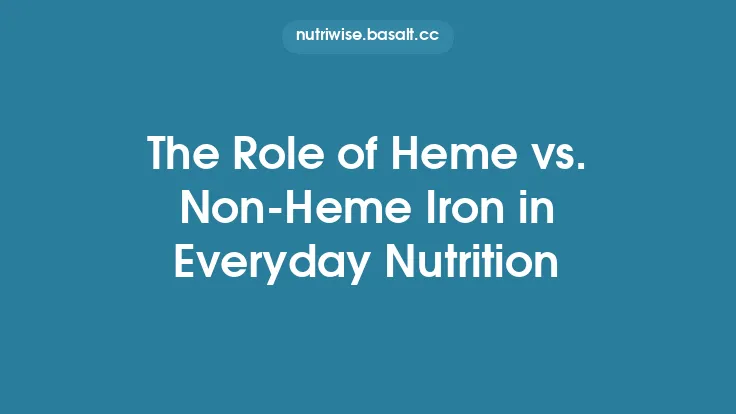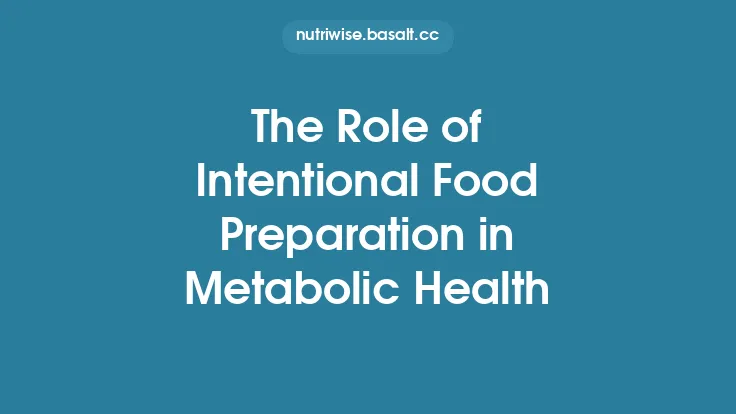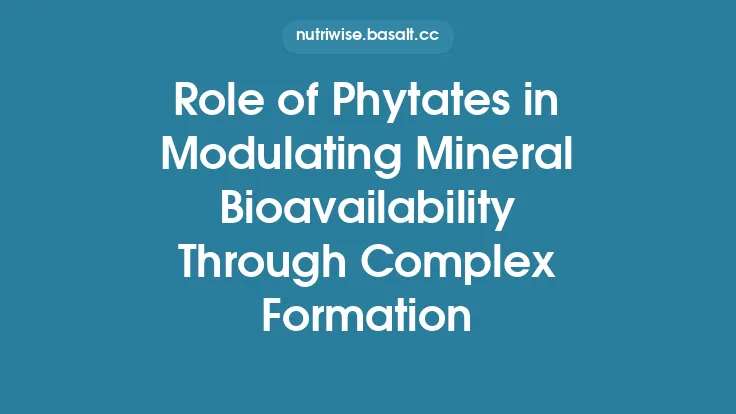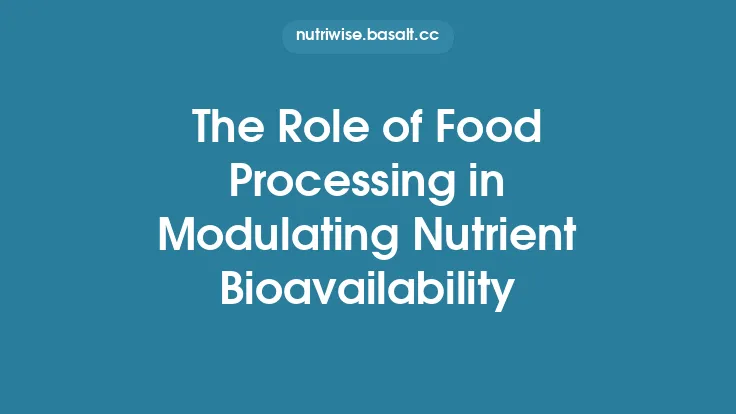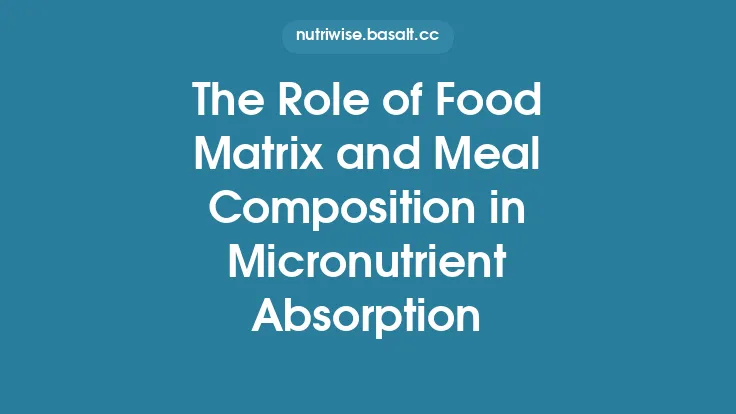Iron is an essential mineral that plays a pivotal role in oxygen transport, cellular respiration, and numerous enzymatic processes. While dietary intake is the primary source of iron, the proportion of that iron that actually becomes available for absorption—its bioavailability—depends heavily on the chemical form of iron in foods and the way those foods are prepared. Cooking methods can either preserve, enhance, or diminish iron’s accessibility to the body by altering the food matrix, influencing the presence of absorption inhibitors or enhancers, and modifying the chemical state of iron itself. Understanding these mechanisms is crucial for nutrition professionals, food technologists, and anyone seeking to optimize iron status through diet.
The Chemistry of Dietary Iron: Heme vs. Non‑Heme
- Heme Iron
Found primarily in animal tissues (muscle, liver, poultry, fish), heme iron is incorporated into the porphyrin ring of hemoglobin and myoglobin. Its molecular structure shields the iron atom from many dietary inhibitors, allowing it to be absorbed efficiently (≈15‑35 % of intake). Cooking can cause denaturation of the heme protein, but the iron remains largely bioavailable because the heme moiety is still recognized by the intestinal heme transporter (heme carrier protein 1, HCP1).
- Non‑Heme Iron
Present in plant foods (legumes, grains, nuts, leafy greens) and in animal foods as ferric (Fe³⁺) or ferrous (Fe²⁺) salts, non‑heme iron is more susceptible to dietary factors that either block or promote its uptake. Baseline absorption rates are lower (≈2‑20 % of intake) and are highly variable, depending on the presence of phytates, polyphenols, calcium, and organic acids.
The distinction between these two forms underpins why cooking strategies that affect the food matrix can have markedly different outcomes for heme versus non‑heme iron.
How Heat Alters Iron Speciation and Food Matrix
- Thermal Reduction of Ferric to Ferrous Iron
Ferrous iron (Fe²⁺) is the preferred substrate for the divalent metal transporter 1 (DMT1) in the duodenum. Certain cooking processes—especially those involving moist heat at moderate temperatures (e.g., steaming, simmering)—can promote the reduction of Fe³⁺ to Fe²⁺, particularly in the presence of reducing agents such as ascorbic acid or sulfite. This conversion can increase the proportion of absorbable iron in legumes and whole grains.
- Denaturation of Proteins and Release of Bound Iron
High‑temperature dry‑heat methods (roasting, grilling, frying) cause protein unfolding and aggregation. In animal tissues, this can expose heme groups that were previously sequestered within muscle fibers, potentially enhancing heme iron release. Conversely, excessive charring may generate insoluble iron complexes that are less bioavailable.
- Leaching of Water‑Soluble Inhibitors
Boiling and pressure cooking can leach phytates, oxalates, and certain polyphenols into the cooking water. If the cooking liquid is discarded, the concentration of these inhibitors in the final dish is reduced, thereby improving non‑heme iron absorption. However, if the liquid is retained (e.g., in soups or stews), the inhibitors remain present and may counteract the benefit.
- Formation of Maillard Reaction Products (MRPs)
Dry‑heat cooking at temperatures above 150 °C induces Maillard browning between reducing sugars and amino acids. Some MRPs can bind iron, forming complexes that are poorly absorbed. The extent of this effect depends on cooking time, temperature, and the presence of reducing sugars. Short, high‑heat searing may limit MRP formation compared to prolonged roasting.
- pH Shifts During Cooking
Acidic environments (e.g., adding tomatoes, vinegar, or citrus juice) can increase iron solubility by maintaining iron in the ferrous state and by chelating inhibitors. Alkaline conditions (e.g., adding baking soda to beans) can reduce phytate solubility but may also precipitate iron as insoluble hydroxides if the pH rises too high.
Cooking Techniques and Their Specific Impacts on Iron Bioavailability
1. Boiling and Simmering
- Mechanism: Water-soluble inhibitors diffuse into the cooking water; iron may also leach out, especially from vegetables.
- Effect on Non‑Heme Iron: When the cooking water is discarded, phytate and oxalate levels drop, often resulting in a 20‑30 % increase in absorbable iron from legumes and whole grains. Retaining the water mitigates this benefit.
- Effect on Heme Iron: Minimal impact on heme iron content; however, prolonged boiling can cause some loss of water‑soluble heme peptides.
2. Steaming
- Mechanism: Food is cooked by saturated steam, limiting direct contact with water.
- Effect on Non‑Heme Iron: Retains most of the food’s intrinsic iron while still reducing some inhibitors through heat‑induced structural changes. Studies show a modest (≈10‑15 %) rise in iron absorption from steamed spinach compared with raw.
- Effect on Heme Iron: Preserves heme integrity better than boiling, maintaining high bioavailability.
3. Pressure Cooking
- Mechanism: High temperature (≈120 °C) and pressure accelerate gelatinization of starches and breakdown of cell walls.
- Effect on Non‑Heme Iron: Dramatically reduces phytate content (up to 70 % in beans) and improves iron solubility. The rapid cooking time also limits the formation of MRPs. Resulting iron absorption can increase by 40‑50 % relative to conventional boiling.
- Effect on Heme Iron: No significant loss; the short cooking time helps retain moisture and heme structure.
4. Roasting and Baking
- Mechanism: Dry heat causes Maillard reactions and caramelization.
- Effect on Non‑Heme Iron: Potentially detrimental if prolonged, due to MRP‑iron complexes. However, moderate roasting (≤30 min at 180 °C) can improve iron release from seeds by breaking cell walls.
- Effect on Heme Iron: May increase heme iron availability by disrupting muscle fibers, but excessive charring can produce insoluble iron oxides.
5. Grilling and Broiling
- Mechanism: Direct high‑temperature exposure; often accompanied by fat drippings.
- Effect on Non‑Heme Iron: Limited impact unless the food is heavily charred. The formation of iron‑binding polycyclic aromatic compounds can reduce absorption.
- Effect on Heme Iron: Similar to roasting; short searing can enhance heme release, but over‑cooking may create insoluble iron aggregates.
6. Frying (Shallow and Deep)
- Mechanism: Food contacts hot oil, leading to rapid surface dehydration and Maillard browning.
- Effect on Non‑Heme Iron: The high temperature can promote iron reduction, but the presence of oil may impede iron release from the food matrix. Additionally, oil can solubilize fat‑soluble polyphenols that act as inhibitors.
- Effect on Heme Iron: Generally preserves heme iron, though the formation of a crust can trap iron within the protein matrix, slightly reducing immediate bioavailability.
7. Fermentation and Sprouting (Pre‑Cooking Treatments)
- Mechanism: Microbial enzymatic activity or germination activates phytase, which hydrolyzes phytate.
- Effect on Non‑Heme Iron: Substantial increase in bioavailable iron (up to 2‑fold) when combined with subsequent cooking. Fermented porridges or sprouted lentils retain higher iron levels after steaming or boiling.
- Effect on Heme Iron: Minimal direct effect, but fermented meat products (e.g., cured sausages) may have altered heme structures that affect absorption.
Interactions Between Cooking Methods and Iron Enhancers
- Vitamin C (Ascorbic Acid): Adding citrus juice, tomato puree, or bell pepper during cooking can maintain iron in the ferrous state and form soluble iron‑ascorbate complexes. Heat‑stable ascorbate added at the end of cooking (or as a raw garnish) maximizes this effect.
- Meat Factor: The presence of animal tissue (muscle protein, peptides) during cooking of plant foods (e.g., meat‑based stews with beans) can enhance non‑heme iron absorption by up to 3‑fold. The cooking process releases peptide fragments that act as iron carriers.
- Organic Acids: Incorporating vinegar or wine during braising lowers pH, improving iron solubility. Acidic cooking liquids also help prevent precipitation of iron as hydroxides.
Practical Recommendations for Maximizing Iron Bioavailability Through Cooking
| Food Type | Preferred Cooking Method(s) | Key Adjustments |
|---|---|---|
| Legumes (beans, lentils, chickpeas) | Pressure cooking + brief steaming | Discard cooking water; add a squeeze of lemon or a few tomatoes at the end |
| Whole Grains (brown rice, quinoa, millet) | Soak → pressure cook or steam | Soak 6–12 h to activate phytase; use minimal water; retain cooking liquid if fortified with vitamin C |
| Leafy Greens (spinach, kale) | Light steaming or quick sauté | Add garlic (contains sulfur compounds that may aid iron release) and a splash of orange juice |
| Red Meat (beef, lamb) | Short searing or grilling (≤5 min per side) | Avoid excessive charring; finish with a squeeze of lime to maintain ferrous iron |
| Poultry (chicken, turkey) | Stewing or braising with vegetables | Include carrots, bell peppers, and a tomato base for vitamin C synergy |
| Fish (especially oily varieties) | Baking or steaming | Pair with citrus zest; avoid over‑cooking to preserve heme integrity |
| Nuts & Seeds | Light roasting (≤15 min at 150 °C) | Combine with dried fruit rich in vitamin C (e.g., dried apricots) post‑roast |
Additional Tips
- Avoid Prolonged High‑Heat Browning: Limit the duration of dry‑heat methods that produce heavy crusts or blackened edges.
- Utilize Cooking Liquids: When feasible, incorporate the cooking broth into the final dish, especially if the broth has been enriched with vitamin C or meat extracts.
- Combine Food Groups: Design meals that pair non‑heme iron sources with heme proteins or vitamin C‑rich foods during cooking.
- Mind the Order of Ingredient Addition: Add acid‑rich ingredients toward the end of cooking to prevent degradation of heat‑sensitive nutrients while still benefiting iron solubility.
Emerging Research Directions
While the influence of traditional cooking methods on iron bioavailability is well documented, several cutting‑edge areas merit attention:
- High‑Pressure Processing (HPP): Non‑thermal pressure treatments can inactivate phytate‑binding proteins without the heat‑induced losses associated with conventional cooking, potentially preserving both iron and heat‑labile enhancers.
- Ultrasound‑Assisted Cooking: Acoustic cavitation may disrupt plant cell walls more efficiently, facilitating iron release while reducing cooking time.
- Smart Cooking Appliances: Sensors that monitor pH and redox potential in real time could dynamically adjust temperature to maintain iron in the ferrous state.
- Nanostructured Food Matrices: Engineering food particles at the nanoscale to encapsulate iron with protective, bioavailable carriers (e.g., peptide‑iron complexes) could circumvent traditional inhibitor effects.
Concluding Perspective
Cooking is far more than a culinary art; it is a biochemical catalyst that determines how much dietary iron reaches the bloodstream. By selecting appropriate heat treatments, managing the presence of inhibitors, and strategically pairing iron sources with natural enhancers, it is possible to substantially improve iron bioavailability across a wide spectrum of foods. Nutrition professionals should incorporate these cooking‑focused strategies into dietary counseling, especially for populations at risk of iron deficiency such as women of reproductive age, adolescents, and individuals following predominantly plant‑based diets. Continued research into novel processing technologies promises to refine these recommendations further, ensuring that the iron we consume is not only plentiful but also readily usable by the body.
